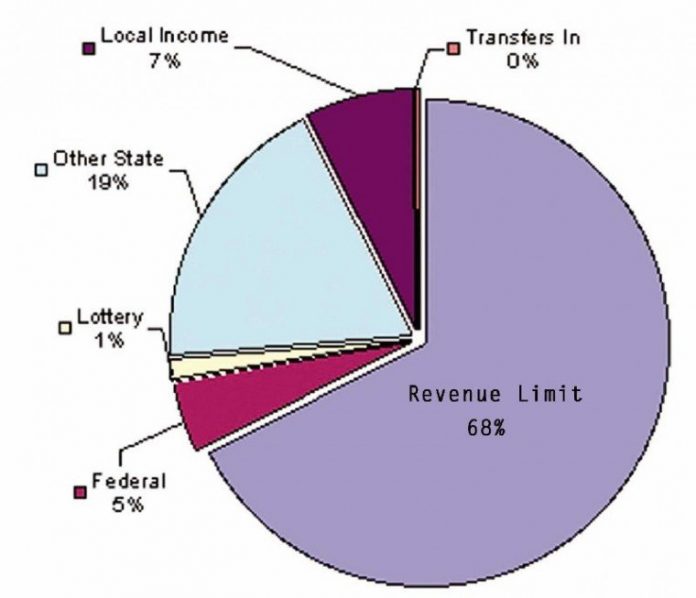The California education budget hasn’t been released yet, but
the school district is talking budget cuts for the next school
year.
The California education budget hasn’t been released yet, but the school district is talking budget cuts for the next school year.
When the governor acknowledged a $14 billion deficit in the state budget, Gilroy Unified School District officials began “preparing for what looks to be a gloomy economic period,” said Assistant Superintendent of Administrative Services Steve Brinkman.
The district is waiting for the proposed state budget for the 2008-2009 school year to come out Jan. 15. In the meantime, the district is evaluating its options.
A large chunk of the district’s revenue falls under the category “revenue limit.” At 68 percent of the district’s budget, revenue limit is the largest and most significant source of general purpose funding and is comprised of state aid and local property taxes. In the 2007-2008 budget, revenue limit sources contributed $56 million, 68 percent of the district’s total revenue of $84 million. Revenue limit can be broken down into $16 million in state aid and $40 million in property taxes.
Additionally, 19 percent of the district budget is supported by state funds that are restricted for specific programs and 1 percent of the budget comes from funds generated by the state lottery.
Ultimately, about 88 percent of the district’s budget will be affected by the state budget, said Keiko Mizuno, the district’s director of business services.
The state Department of Finance has directed state departments and agencies to prepare for a 10 percent budget reduction for 2008-2009. GUSD has recognized its “need to institute fiscal restraints right now in preparation for bad news come January,” Brinkman said.
Superintendent Deborah Flores and the school board attended the California School Board Association Conference in San Diego at the beginning of the month and received advice from financial experts about the state budget process, Flores said.
“We knew it was serious when the governor flew down to meet with top leadership to discuss the status of the state budget crisis,” she said. Flores alerted her staff and principals of the severity of the situation and of the possibility of the impact on the current school year.
With the threat of midyear budget cuts, Flores plans to begin study sessions immediately following news of next year’s budget. The board has expressed a strong desire to be more engaged in this year’s budget planning process.
The board was immersed in the search for a new superintendent last year and hopes to be more involved in setting priorities this year, Trustee Francisco Dominguez said.
“We need to have a conversation early about whether or not we’ll be making reductions,” he said. “We don’t want any surprises.”
Priorities will have to be set given the tight budget, Flores said.
“We don’t have a lot of wiggle room,” she said. “There’s not a lot of fat in this budget. The process of setting priorities will be long and difficult.”
One option to reduce expenditures is to increase class size ratios, Flores said. Another option is to reduce funding for out-of-state teacher workshops and to limit overtime, Mizuno said.
Until she receives more specific numbers about the state budget, Flores said she was unable to predict whether or not layoffs would be an option.
Although the district won’t cut the salary or benefits of its teachers this year, officials will negotiate teacher pay for next school year after they become aware of the full impact of the state budget cuts, Flores said. She does not expect making pay cuts but said the issue of raises will have to be addressed.
“It’s important to increase all salaries. We are already having trouble recruiting,” Flores said. “But can we afford a salary increase?”
Trustee Denise Apuzzo also voiced her concern for how the budget cuts might impact teacher raises.
“That’s the No. 1 issue,” she said. Apuzzo had hoped to give the teachers a substantial raise this year when the budget yielded surplus funds. However, she pointed out that most extra funds were allocated for the construction of Christopher High School. The steel bid came in at $4 million over budget.
“It threw us off that Christopher High School is affecting the entire budget. It’s encroaching on the general fund,” Apuzzo said.
Considering the state budget’s gloomy outlook, she said those substantial raises may no longer be realistic. She also said that spending freezes have been enacted in the past when the budget suffers at the state level.
“It puzzles me that despite our growth, our salaries are not keeping pace with the county,” said Michelle Nelson, the president of the Gilroy Teacher’s Association. Having negotiated the teacher contracts, she wasn’t concerned about pay cuts but said that when the budget is cut, teachers often have to purchase their own classroom supplies. “They have to go out and buy their own paper, but teachers do what they have to teach the kids.”















